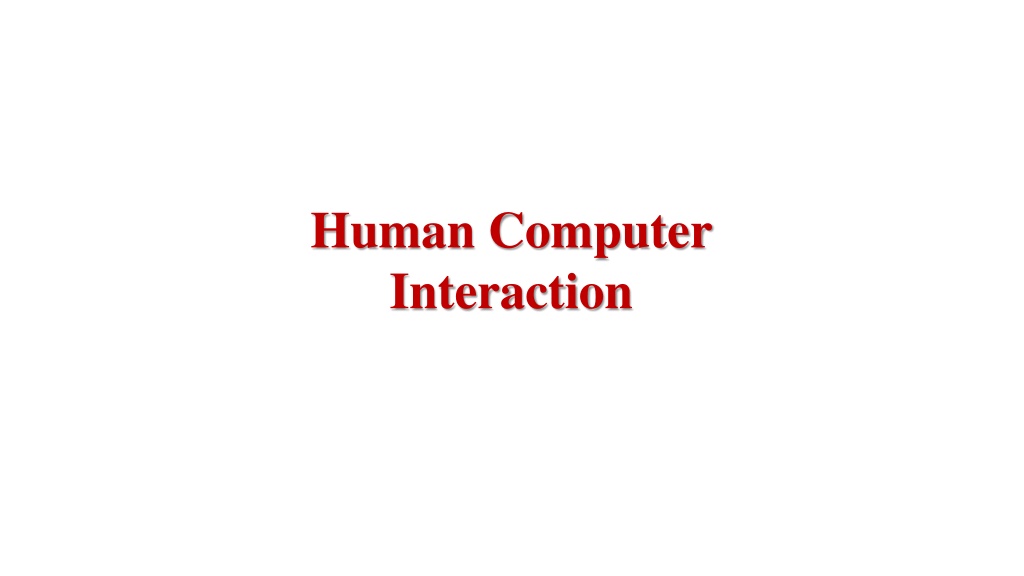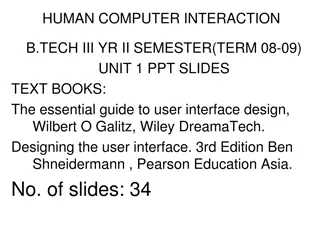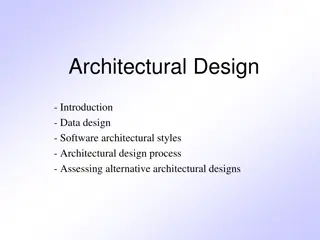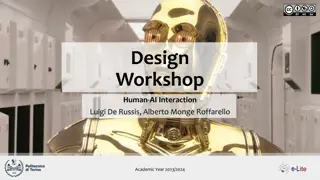Understanding Interaction Design in Human-Computer Interaction
Interaction design focuses on creating interactive products that are easy, effective, and enjoyable to use. It aims to reduce negative user experiences while enhancing positive ones. Designing interactive products requires understanding user activities, interfaces, and device arrangements to support diverse activities. Interaction design encompasses user interface design, software design, user-centered design, and more, emphasizing user experiences in everyday interactions.
- Interaction Design
- User Experience
- Human-Computer Interaction
- User-Centered Design
- Interactive Products
Uploaded on Sep 30, 2024 | 0 Views
Download Presentation

Please find below an Image/Link to download the presentation.
The content on the website is provided AS IS for your information and personal use only. It may not be sold, licensed, or shared on other websites without obtaining consent from the author. Download presentation by click this link. If you encounter any issues during the download, it is possible that the publisher has removed the file from their server.
E N D
Presentation Transcript
Human Computer Interaction
What is Interaction Design? 1. Introduction 2. What is Interaction Design? 3. The User Experience 4. The Components of Interaction Design
Introduction How many interactive products are there in everyday use? smartphone, tablet, computer, remote control, coffee machine, ATM, ticket machine, printer, iPod, GPS, e-reader, TV, electric toothbrush, radio, games console . . . the list is endless. How many are actually easy, effortless, and enjoyable to use? the iPod, are a joy to use. Others, like a ticket machine, can be very frustrating.
Many products that require users to interact with them, such as smartphones and social networking sites, have been designed primarily with the user in mind. They are generally easy and enjoyable to use. Others, such as switching from viewing a rented movie on your smart TV to watching a sports channel, or setting the alarm on a digital clock, have not necessarily been designed with the users in mind, but have been engineered primarily as systems to perform set functions. While they may work effectively, it can be at the expense of how they will be used by real people. One main aim of interaction design is: To reduce the negative aspects (e.g. frustration, annoyance) of the user experience while enhancing the positive ones (e.g. enjoyment, engagement). In essence, it is about developing interactive products that are easy, effective, and pleasurable to use from the users perspective.
What to Design Designing interactive products requires considering: Who is going to be using them, How they are going to be used, Where they are going to be used. Another key concern is to understand the kind of activities people are doing when interacting with the products. The appropriateness of different kinds of interfaces and arrangements of input and output devices depends on what kinds of activities are to be supported. For example: If the activity is to enable people to bank online, then an interface that is secure, trustworthy, and easy to navigate is essential. In addition, an interface that allows the user to find out new information about the services offered by the bank without it being intrusive would be useful. The world is becoming suffused with technologies that support increasingly diverse activities.
What Is Interaction Design? By interaction design, we mean designing interactive products to support the way people communicate and interact in their everyday and working lives . Put another way, it is about creating user experiences that enhance and augment the way people work, communicate, and interact. A number of terms have been used to emphasize different aspects of what is being designed, including user interface design, software design, user centered design, product design, web design, experience design, and interactive system design. Interaction design is increasingly being accepted as the umbrella term, covering all of these aspects. Indeed, many practitioners and designers, who in the 1990s would have described what they were doing as interface design or interactive system design, now promote what they are doing as interaction design. The focus of interaction design is very much concerned with practice, i.e. how to design user experiences. It is not wedded to a particular way of doing design, but is more eclectic, promoting the use of a range of methods, techniques, and frameworks.
The Components of Interaction Design We view interaction design as fundamental to all disciplines, fields, and approaches that are concerned with researching and designing computer based systems for people (see Figure 1.4). Why are there so many and what do they all do? Furthermore, how do the various disciplines, fields, and design approaches differ from one another?
Who Is Involved in Interaction Design? From Figure 1.4 it can also be seen that many people are involved, ranging from social scientists to movie-makers. This is not surprising given that technology has become such a pervasive part of our lives. But it can all seem rather bewildering to the onlooker. How does the mix of players work together? Designers need to know many different things about users, technologies, and interactions between them in order to create effective user experiences. At the very least, They need to understand how people act and react to events and how they communicate and interact with each other. To be able to create engaging user experiences, They also need to understand how emotions work, what is meant by aesthetics, desirability, and the role of narrative in human experience. Developers also need to understand the business side, the technical side, the manufacturing side, and the marketing side.
Clearly, it is difficult for one person to be well versed in all of these diverse areas and also know how to apply the different forms of knowledge to the process of interaction design. Interaction design is mostly carried out by multidisciplinary teams, where the skill sets of engineers, designers, programmers, psychologists, anthropologists, sociologists, artists, toy makers, and others are drawn upon. One of the benefits of bringing together people with different backgrounds and training is the potential of many more ideas being generated, new methods developed, and more creative and original designs being produced. However, the downside is the costs involved. The more people there are with different backgrounds in a design team, the more difficult it can be to communicate and make progress forward with the designs being generated.
People with different backgrounds have different perspectives and ways of seeing and talking about the world. What one person values as important others may not even see. The various team members may have : different ways of talking about design. may use the same terms to mean quite different things. Other problems can arise when a group of people who have not previously worked as a team is thrown together. For example: Philips found that its multidisciplinary teams that were responsible for developing ideas and products for the future experienced a number of difficulties, namely that project team members did not always have a clear idea of who needed what information, when, and in what form.
H.W Q1) What are the negative and positive aspects of interaction design? with examples Q2) What are the considerations when designing interactive products? Q3) Why? a) We need team members with multidisciplinary when designing new products. b) The designer needs to know many thinks about users.

















































